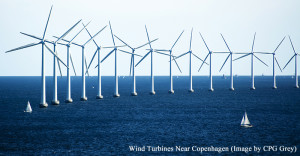
While President Obama promotes renewable energy and members of Congress argue about energy policy, a renewable energy disaster is unfolding in Europe. Driven by a desire to halt climate change, Europe has created a high-cost energy system where everyone loses. U.S. policy leaders should learn from the debacle occurring overseas.
European energy policy today is dominated by the European Climate Change Program (ECCP), which was established by the European Community in 2000. The program called for the nations of Europe to adopt measures to cut greenhouse gas emissions. The goal was for Europe to collectively meet the targets of the Kyoto Protocol climate treaty signed in 1997.
The ECCP was based on two assumptions. The first was that changes to national energy systems were needed to fight global warming. Second, that coal, gas and oil fuels would become more expensive, allowing renewable energy to compete. But policies to promote renewables resulted in substantially higher electricity prices for Europe.
Europe used subsidies and mandates to promote renewables. Feed-in tariffs were enacted in most nations, providing a payment to homeowners and businesses for electricity fed into the grid from solar or wind facilities. Governments paid a fixed subsidy of four to 10 times the wholesale electricity price, guaranteed for up to 20 years, for generated electricity.
Electricity from renewables is also granted grid priority. Utilities are required to accept wind and solar-generated electricity as a first priority, regardless of market demand. Output from traditional coal, natural gas and nuclear plants is scaled back or shut down when renewable output is high. Wholesale electricity prices, once driven by market demand, are today dominated by the weather. When the wind blows and the sun shines, large amounts of electricity are dumped onto the grid from wind and solar installations, forcing wholesale electricity prices negative.
Other factors added to the growing debacle. In 2011, Germany announced a complete phase-out of nuclear power in the wake of the Fukushima disaster in Japan, closing nuclear power plants and straining the electrical system of Europe’s largest economy. In addition, Germany and France banned hydraulic fracturing, ensuring that European natural gas prices will remain high for the next decade.
The results of Europe’s green energy measures have been bizarre. Feed-in tariffs in Germany stimulated more than one million rooftop solar installations. But Germany is not exactly the sun belt. The latitude of central Germany is the same as that of Calgary, Canada. As a result, German solar installations generate electricity at less than 10 percent of rated output. Over a million solar installations provide only 6 percent of Germany’s electricity and 1 percent of the nation’s energy. For this solar miracle, German citizens are obligated to pay over $400 billion in current and future payments to solar providers through higher electricity rates.
Denmark erected over 5,000 wind turbine towers, one for every thousand Danish citizens. Turbines blanket the nation, providing a beautiful view of a 300- to 500-foot tall tower from almost every house, farm, field, forest and beach. But the turbines produce only 1.3 gigawatts each of electricity on average. All could be replaced by a single large conventional power plant. Today, Denmark has the highest electricity prices of the developed nations.
Europe has created an energy system where everyone loses. Consumers, industry, traditional power plants and even renewable energy companies are now losing. Even though wholesale electricity prices are falling, consumer electricity prices have doubled over the last 10 years due to large subsidy payments to renewable companies. Nations with the largest percentage of renewable energy also have the highest electricity prices. Citizens of Spain pay 23 eurocents per kilowatt-hour, three times the U.S. price, and citizens of Germany and Denmark pay more than 25 eurocents per kilowatt-hour, four times the U.S. price.
European industrial companies are also big losers. French firms pay more than twice the U.S. electricity rate and German firms pay three times the rate. European industrial electricity rates have risen more than 50 percent since 2007, while U.S. industrial rates have been flat. European firms also pay double the U.S. price for natural gas. European chemical firms are now building plants in America to utilize low-cost ethane from shale fracking, a technology not available in Europe.
Traditional European electrical power companies are losing as well. The wholesale price of electricity is down 50 percent in the last five years and conventional plants can no longer break even. An example is the Irsching high-efficiency natural gas plant in Germany. Built in 2010, it can operate at 60 percent efficiency. But the plant is not profitable as a backup to renewables. In March, the owners announced a shutdown of the plant.
Last year, E.ON, the largest German utility, suffered its first loss in more than 50 years. Both E.ON and Swedish utility Vattenfall have announced plans to exit their conventional power plant business in Germany in favor of renewables. Magnus Hall, president of Vattenfall, stated last year, “It makes it difficult to see how you could invest in conventional generation under these circumstances.”
Finally, even renewable energy companies are now losing. European governments have realized that they can no longer afford the green energy revolution. Subsidies have recently been cut in Belgium, Germany, Greece, Italy, Spain and the United Kingdom. In Germany, solar employment dropped 50 percent and many renewable companies declared bankruptcy. Spain ended its feed-in tariff subsidy and placed a cap on renewable industry profits, resulting in 75,000 lost renewable jobs and a 90 percent reduction in solar installations.
U.S. energy policy makers should learn from Europe’s energy experience and pursue sensible energy economics.
Steve Goreham is executive director of the Climate Science Coalition of America and author of the book The Mad, Mad, Mad World of Climatism: Mankind and Climate Change Mania.
